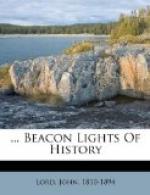enough, nor learned enough, to enter upon the discussion
of those high themes which agitated the schools and
universities, as Dante did one hundred years before.
He tells us how monks and friars lived, not how they
dreamed and speculated. Nor are his sarcasms
scorching and bitter, but rather humorous and laughable.
He shows himself to be a genial and loving companion,
not an austere teacher of disagreeable truths.
He is not solemn and intense, like Dante; he does
not give wings to his fancy, like Spenser; he has
not the divine insight of Shakspeare; he is not learned,
like Milton; he is not sarcastic, like Pope; he does
not rouse the passions, like Byron; he is not meditative,
like Wordsworth,—but he paints nature with
great accuracy and delicacy, as also the men and women
of his age, as they appeared in their outward life.
He describes the passion of love with great tenderness
and simplicity. In all his poems, love is his
greatest theme,—which he bases, not on
physical charms, but the moral beauty of the soul.
In his earlier life he does not seem to have done
full justice to women, whom he ridicules, but does
not despise; in whom he indeed sees the graces of
chivalry, but not the intellectual attraction of cultivated
life. But later in life, when his experiences
are broader and more profound, he makes amends for
his former mistakes. In his “Legend of
Good Women,” which he wrote at the command of
Anne of Bohemia, wife of Richard II., he eulogizes
the sex and paints the most exalted sentiments of the
heart. He not only had great vividness in the
description of his characters, but doubtless great
dramatic talent, which his age did not call out.
His descriptions of nature are very fresh and beautiful,
indicating a great love of nature,—flowers,
trees, birds, lawns, gardens, waterfalls, falcons,
dogs, horses, with whom he almost talked. He
had a great sense of the ridiculous; hence his humor
and fun and droll descriptions, which will ever interest
because they are so fresh and vivid. And as a
poet he continually improved as he advanced in life.
His last works are his best, showing the care and
labor he bestowed, as well as his fidelity to nature.
I am amazed, considering his time, that he was so
great an artist without having a knowledge of the
principles of art as taught by the great masters of
composition.
But, as has been already said, his distinguishing excellence is vivid and natural description of the life and habits, not the opinions, of the people of the fourteenth century, described without exaggeration or effort for effect. He paints his age as Moliere paints the times of Louis XIV., and Homer the heroic periods of Grecian history. This fidelity to nature and inexhaustible humor and living freshness and perpetual variety are the eternal charms of the “Canterbury Tales.” They bring before the eye the varied professions and trades and habits and customs of the fourteenth century. We see how our ancestors dressed and talked and ate; what




